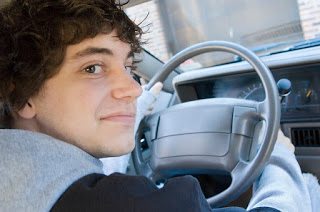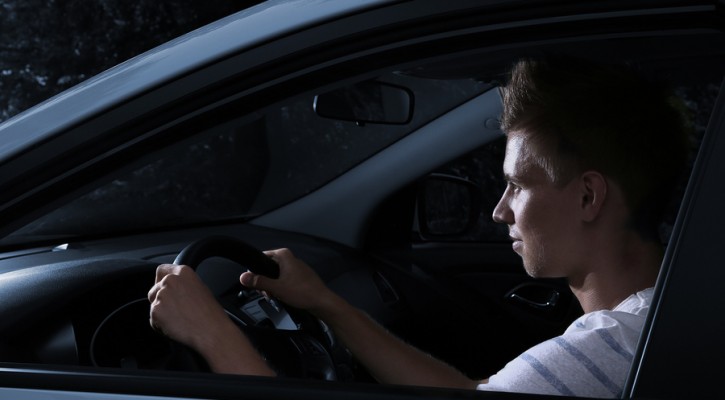Tag Archive: motor vehicle crashes

Motor Vehicle Crashes More Frequent For Teens with Own Cars
November 23, 2009
The journal Pediatrics recently published a study that showed that teens who report having their own vehicles (vehicles they don’t share with other family members) are more than twice as likely to have been involved in a recent motor vehicle crash. The study, a survey of 2,167 teens by researchers at Children’s Hospital of Philadelphia, indicated that teens who have their own vehicles are also much more likely to participate in other risky driving behaviors, such as using a cell phone and speeding.
Why might this be? According to driver safety experts, the following aspects of teens having vehicles for their sole use are potential contributors to the higher motor vehicle collision rate:
- The teen is more likely to have selected their own vehicle: Meaning a small, sporty car; high-powered, easily maneuverable vehicles tempt teens to drive faster and take more chances behind the wheel, such as weaving in and out of traffic.
- More driving time: When teens share a vehicle with other family members, they simply aren’t on the road as much. Teens who must return the vehicle by a certain hour so another family member can use it have a natural curfew that limits time on the road. While more driving time might make a teen driver more comfortable behind the wheel, she or he is not necessarily more skilled at driving. A false sense of confidence can lead teen drivers to take risks on the road.
- Extra freedom: When teens don’t have to request the keys, they quickly fall into the habit of driving whenever and wherever they want, and parents just as quickly get used to the freedom of not having to give rides to boisterous teens and their friends. This means that teens take more frequent trips, in addition to staying out longer.
- More passengers: Teens who don’t have to share their vehicles with their parents gain status amongst their friends because they can offer transportation to those who don’t have access to family vehicles. More time in the vehicle with teen passengers means trouble – teen passengers make driving much more risky for teen drivers.
Statistically, it’s safer for your teen to share a family vehicle rather than having one of their own. For parents who still intend to buy their teens their own vehicles, traffic safety professionals offer the following guidelines:
- Choose the vehicle carefully; research your options thoroughly. Teen drivers need stable, midsize vehicles with all the safety features you can afford. Frankly, if your teen is happy with your selection, it’s a sign that you may need to reevaluate your options and choose a different vehicle.
- Make sure your teen adheres to the Graduated Driver Licensing (GDL) laws in your state. If your state doesn’t impose time limitations for teen drivers, create your own as part of your house rules. Match the number of hours your teen is allowed to drive to the level of responsibility and maturity she or he exhibits.
- Don’t allow your teen to equate having her or his own vehicle to having unrestricted driving time. Set limits on the frequency and purpose for driving trips. Accompany your teen on trips in their vehicle occasionally and observe their driving behavior carefully, watching for any bad driving habits they may have picked up while driving alone.
- Use GDL laws and the number of safety belts in your car to determine the maximum number of passengers your teen is allowed to have in the vehicle.
Check frequently to make sure your teen is complying with your restrictions. Review your cell phone bill to ensure that your teen is not making calls when she or he is typically behind the wheel. Any deviation from the rules should result in restricted (or removed) driving privileges for a specified period of time. If teens aren’t following the ground rules for use of the vehicle, parents need to penalize them by taking the keys away and acting as chauffeurs for a time.

Teens and Motor Vehicle Crashes
August 28, 2009
The tragedy occurred on the last day before summer vacation. An SUV transporting a group of teens to the beach rolled over after a tire blowout. In the aftermath, four teens died, four were hospitalized, and the teen driver faced criminal charges.
Almost everyone knows a distressing story like this one; deaths of teens due to motor vehicle crashes are often well-publicized amid great community sympathy for the loss of young lives and the potential they held, as well as the devastation of surviving parents and friends. And they speak to a larger statistical reality – that motor vehicle crashes are the leading cause of death for 15- to 20-year-olds, according to the National Center for Health Statistics – that much of America seems to be both aware of, but unsure of how to change.
Consider the following statistics from the National Highway Traffic Safety Administration (NHTSA):
- There were 202.8 million licensed drivers in the United States in 2006 (2007 data not available). Young drivers between 15 and 20 years old accounted for 6.4 percent (13.0 million) of the total, a 7.2-percent increase from the 12.1 million young drivers in 1996.
- In 2007, 13 percent (6,982) of all drivers involved in fatal crashes (55,681) were young drivers age 15 to 20 years old, and 15 percent (1,631,000) of all drivers involved in police-reported crashes (10,524,000) were young drivers.
- In 2007, 3,174 15- to 20-year-old drivers were killed and an additional 252,000 were injured in motor vehicle crashes.
- Among 15- to 20-year-old drivers involved in fatal crashes in 2007, 31 percent of the drivers who were killed had been drinking.
- In 2007, 64 percent of the young drivers of passenger vehicles involved in fatal crashes who had been drinking were unrestrained. Of the young drivers who had been drinking and were killed in crashes, 75 percent were unrestrained. -During 2007, 35 percent of the motorcycle riders between 15 and 20 years old who were fatally injured in crashes were not wearing helmets.
In addition to mistakes made while driving, teens are susceptible to other lapses in judgment concerning motor vehicles that can lead to injury or death, such as car surfing. According to Science Daily, the states with the highest car-surfing fatality rates are California, Florida, and Texas; all three states have shown an increase in car-surfing deaths since 2000.
Though these three states show high levels of risky teen behavior concerning motor vehicles, a study conducted by Allstate Insurance Company indicated that rural areas have much higher rates of fatal motor vehicle crashes involving teen drivers than metropolitan areas; consequently, states with large rural areas have the highest rates of fatal crashes involving teen drivers. These states are:
- Mississippi
- Alabama
- Kentucky
- Missouri
- Arkansas
Nationally, Allstate’s research showed, fatal crash rates for teens were more than twice as high in rural areas than in metropolitan areas.
While considerable attention is paid to the issue of drunk driving among teens, law enforcement agencies report that speeding is the leading cause of motor vehicle crashes involving teen drivers. Allstate’s study found that law enforcement identified speeding as a factor in 34% of motor crashes nationwide, while alcohol was cited in just 12% of crashes.
In addition to the risk teens take when driving or when riding in a vehicle with other teens, teens suffer when a member of their peer group dies in a motor vehicle crash, particularly when they suffer multiple losses from crashes such as the example at the beginning of this article. Because of the feeling of invincibility that is characteristic of this age group, teens typically have not considered the deaths of people their age a possibility, so when such a thing occurs, their world may seem to be crashing down around them. This means that even teens who were not particularly close to the person who died can be stunned by their reaction to it. Due to their level of psychological maturity, teens are ill-equipped to understand the grieving process and may be overwhelmed by feelings of being out-of-control, insecure, and scared, in addition to sorrow and grief. They may descend into melancholy that lasts years, greatly affecting their development. Some teens numb their feelings by participating in high-risk activities such as:
- Alcohol and drug abuse
- Reckless sexual activity
- Withdrawal from family and friends
- Taking risks involving motor vehicles
Depending on the loss, some teens experience a change in their circle of friends. Obviously, this can have positive or negative results, but regardless, it is another change in a rapidly changing world for the teen. Teens who lose friends to death may see their grades drop and their focus change as they struggle to fit into a new group of friends at a time when they feel especially vulnerable.
Parents and other authority figures can help teens channel their grief in healthier ways by:
- Being available to listen – not, necessarily, to talk
- Allowing teens the freedom to process their grief with others, such as friends, extended family, and professional counselors
- Encouraging teens to express themselves through writing, drawing, and memorializing their deceased friends
- Realizing that the teens’ mourning process may be prolonged and letting teens know that there is no timetable for grief
Though the federal government, state governments, and community-based organizations are making efforts to reduce the number of teens who die in motor vehicle crashes, the statistics above indicate that there is still much work to be done. Forty-six states and the District of Columbia have three-stage Graduated Driver Licensing (GDL) programs in which restricted licenses are issued to beginning teen drivers, with the restrictions reduced over time. However, no state has incorporated all of the GDL components recommended by the Insurance Institute for Highway Safety, the National Transportation Safety Board, and NHTSA.
State-level programs that include peer-to-peer teaching and learning about driver safety are effective in reducing teen motor vehicle crash rates. Texas’ Teens in the Driver Seat is one such program; teen crash deaths have dropped 32% and the number of teen drivers involved in fatal motor vehicle crashes is down 33% since the program began. A similar program in Illinois called Operation Teen Safe Driving has helped achieve a 10% reduction in teen motor vehicle fatalities in Illinois during the first seven months of 2009. Mothers Against Drunk Driving (MADD), Students Against Destructive Decisions (SADD) and other advocacy groups sponsor many public education campaigns to persuade teens not to drive under the influence of alcohol or drugs.

Five Worst Teen Driving Mistakes: Part Four
January 12, 2009
Most parents live in dread of the day their teens get a driver’s license and get behind the wheel alone. Their concerns are well-founded, since teen drivers have the highest death rates in car crashes of any age group. Motor vehicle crashes are the number one cause of death among Americans aged 15-20. But parents can help their teens be a safer driver even after they are licensed, particularly by paying attention to common risk factors.
In this five-part series, we’ll discuss the five worst teen driving mistakes:
- They don’t wear safety belts.
- They drink and drive.
- They panic/overcorrect in emergency situations.
- They drive too fast for conditions.
- They ride with other teens.
In this, part four of the series, we’ll discuss a frequent cause of collisions for teen drivers – driving too fast for conditions. In addition to succumbing to the lure of speeding on a straight, dry road, teens often fail to lower their speeds on hazardous roads or in dangerous weather conditions. They may compensate for heavy traffic by weaving in and out of traffic and braking more frequently instead of simply reducing speed.
Higher speeds reduce maneuverability, increase stopping distances, and decrease reaction time. Problems caused by increased speed are often magnified in adverse conditions, such as poor visibility or on wet or snowy roads. Teach your teen to be prepared to adjust speed for varying conditions and situations. Different traffic, roadway, and weather conditions can change the amount of time and space needed for slowing down while maintaining control of the vehicle.
Be sure to let your teen practice driving with you in the passenger seat in a variety of road and weather conditions, even after your teen has a driver’s license. Ask your teen to identify the roadway surfaces and conditions at the beginning of each lesson. If the weather changes while you are driving, be sure your teen responds appropriately. For example, if it is sunny when you start out but begins raining during your drive, make sure your teen reduces speed to accommodate the slippery road surface.
Make sure your teen maintains an appropriate following distance at all times. Check your driver handbook for the recommended following distance in your state. Teach your teen to add seconds to the minimum following distance for poor road conditions, bad weather, poor visibility such as in darkness or fog, or in any area where additional hazards are present.
Review the following points about speed with your teen:
- Speeding reduces a driver’s ability to steer safely around curves on the highway or avoid objects in the roadway.
- Speeding extends the distance necessary to stop the vehicle, increases the distance a vehicle travels while a driver reacts, and reduces the effectiveness of the vehicle’s safety features.
- The faster the vehicle is traveling, the greater the impact if the vehicle does crash. Inversely, the effectiveness of restraint devices like airbags and safety belts and vehicular construction features such as crumple zones and side member beams decline as impact speed increases.
- The probability of a disfiguring or debilitating injury or death increases with higher speed on impact.
- The economic cost to society of speeding-related crashes is estimated by the National Highway Traffic Safety Administration to be 40.4 billion dollars per year.
Make sure your home driver education program is complete; use a Driving Log to keep track of your teen’s progress.
Five Worst Teen Driving Mistakes: Part One
Five Worst Teen Driving Mistakes: Part Two
Five Worst Teen Driving Mistakes: Part Three
